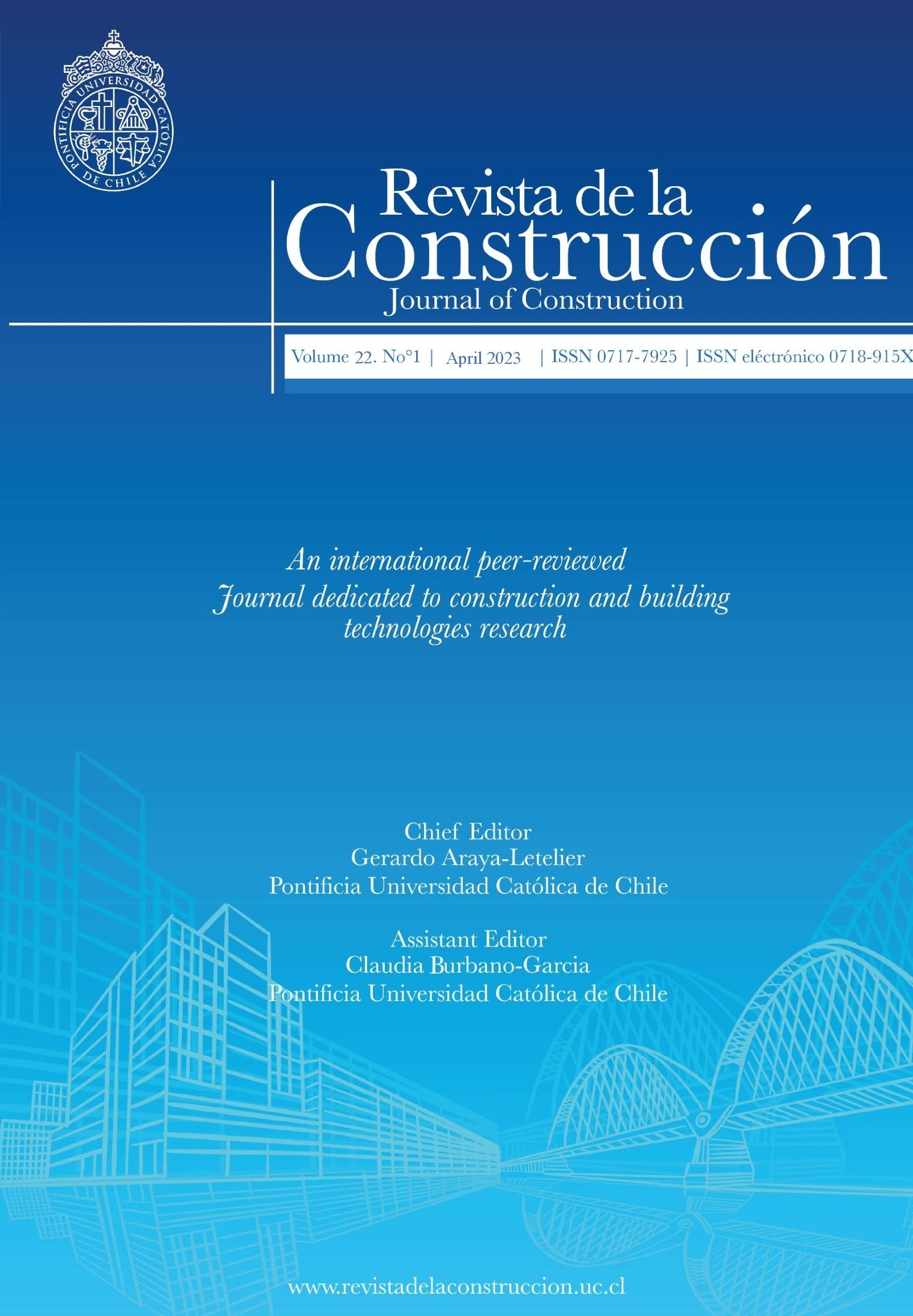Semi-active structural vibrations control with magneto-rheological damper based on the hybrid fuzzy sliding mode controller
DOI:
https://doi.org/10.7764/RDLC.22.1.36Keywords:
Semi-active control, Fuzzy sliding mode, MR damper, Vibration suppression, earthquake excitation.Abstract
Recently, the semi-active control of structural vibration has demonstrated its ability to preserve human life and keep structures safe during earthquakes. In the civil engineering area, the literature is full of investigation in both numerical and experimental research in which the Magneto-Rheological damper is the most used device. This paper investigates the semi-active control of three scaled excited structures. The proposed control is assured by a Magneto-Rheological damper controlled using a hybrid Fuzzy Sliding Mode controller. Although, a Clipped optimal algorithm is proposed to calculate the required current for the damper operating. Otherwise, the robustness of the suggested controller is proved by the obtained numerical results of the seismic excited scaled structure. Therefore, the tested structure is subjected to four time-scaled earthquake records. Finally, the effectiveness of the proposed semi-active control strategy in mitigating earthquake structural vibration is shown clearly in the compared controlled and uncontrolled responses. The simulation results show that the peak reduction reaches 65% under the 2011 Tōhoku earthquake. In addition, the performance indices prove the robustness of the proposed strategy.
Downloads
References
Bartolini G. (1989). Chattering Phenomena in Discontinuous Control Systems. International Journal of Systems Science, 20(12), 2471-2481.
Bingham E. C. (1916). An Investigation of the Laws of Plastic Flow. U.S. Bureau of Standards Bulletin, 13, 309-353.
Blachowski B., & Pnevmatikos N. (2018). Neural Network Based Vibration Control of Seismically Excited Civil Structures. Periodica Polytechnica Civil Engineering, 62(3), 620-628.
Bousserhane I. K., Hazzab A., Rahli M., Mazari B., & Kamli M. (2006). Fuzzy Sliding Mode Based on Indirect Field Orientation for Induction Motor Drive. 32nd Annual Conference on IEEE Industrial Electronics, Paris, France.
Eker I. (2006). Sliding Mode Control with PID Sliding Surface and Experimental Application to an Electromechanical Plant. ISA Transactions, 45(1), 109-118.
Fali L., Djermane M., Zizouni K., & Sadek Y. (2019). Adaptive sliding mode vibrations control for civil engineering earthquake excited structures. Interna-tional Journal of Dynamics and Control. 7(3), 955-965.
Fali L., Sadek Y., Djermane M., & Zizouni K. (2018). Nonlinear Vibrations Control of Structure under Dynamic loads. The 4th Student Symposium on Application Engineering of Mechanics SSAEM’4, Bechar, Algeria.
Fali L., Zizouni K., Saidi A., Ghomri T., Bousserhane I. K., & Djermane M. (2022). Structural Vibration Control in Excited Structures: History and Pro-spects. Journal of Vibration Engineering & Technology. (Article in press).
Ghaffari A., Hashemabadi S. H., & Ashtiani M. (2015). A review on the simulation and modeling of magnetorheological fluids. Journal of Intelligent Ma-terial Systems and Structures, 26(8), 881-904.
Ismail M., Ikhouane F., & Rodellar J. (2009). The Hysteresis Bouc-Wen Model, a Survey. Archives of Computational Methods in Engineering, 16, 161-188.
Jolly M.R., Bender J.W., Carlson J.D. (1999). Properties and Applications of Commercial Magnetorheological Fluids. Journal of Intelligent Material Sys-tems and Structures. 10(1), 5-13.
Phu D. X., Choi S. M., & Choi S. B. (2017). A New Adaptive Hybrid Controller for Vibration Control of a Vehicle Seat Suspension Featuring MR Damper. Journal of Vibration and Control, 23(20), 3392-3413.
Saeed M.U., Sun Z., & Elias S. (2022) Research developments in adaptive intelligent vibration control of smart civil structures. Journal of Low Frequency Noise, Vibration and Active Control. 41(1), 292-329.
Saidi A., Zizouni K., Kadri B., Fali, L., & Bousserhane I.K. (2019). Adaptive sliding mode control for semi-active structural vibration control. Studies in Informatics and Control, 28(4), 371-380.
Savaia G., Panzani G., Corno M., Cecconi J., & Savaresi, S. M. (2021). Hammerstein–Wiener modelling of a magneto-rheological damper considering the magnetization dynamics. Control Engineering Practice, 112, 104829.
Spaggiari A. (2013). Properties and applications of Magnetorheological fluids. Frattura ed Integrità Strutturale, 7(23), 57-61.
Spencer B. F., Dyke S. J., Sain M. K., & Carlson J. D. (1997). Phenomenological model for Magnetorheological Dampers. Journal of Engineering Mechan-ics, 123(3), 230-238.
Wang J. (2020). A seismic-shielding structure based on phononic crystal. Revista de la Construcción, 19(3), 272-287.
Yu W., Thenozhi S., & Li X. (2014). Stable Active Vibration Control System for Building Structures using PD/PID Control. 19th World Congress of the International Federation of Automatic Control Volumes. Cape Town, South Africa, 47(3), 4760-4765.
Zapateiro M., Karimi H. R., Luo N., Phillips B. M., & Spencer B. F. (2009). Semiactive Backstepping Control for Vibration Reduction in a Structure with Magnetorheological Damper Subject to Seismic Motions. Journal of Intelligent Material Systems and Structures, 20(17), 2037-2053.
Zhang, X., & Li, Z. (2016). Sliding-Mode Observer-Based Mechanical Parameter Estimation for Permanent Magnet Synchronous Motor. IEEE Transac-tions on Power Electronics. 31(8), 5732-5745.
Zhang Y., Li D., Cui H., & Yang, J. (2020). A new modified model for the rheological properties of magnetorheological fluids based on different magnetic field. Journal of Magnetism and Magnetic Materials, 500, 166377.
Zizouni K., Bousserhane I. K., Hamouine A., & Fali L. (2017). MR Damper-LQR Control for Earthquake Vibration Mitigation. International Journal of Civil Engineering and Technology, 8(11), 201-207.
Zizouni K., Fali L., Bousserhane I.K., Sadek Y. (2020). Active mass damper vibrations control under earthquake loads. International Journal of Advances in Mechanical and Civil Engineering. 7(2), 26-30.
Zizouni K., Saidi A., Fali L., Bousserhane I.K., & Djermane, M. (2022). Adaptive sliding-mode control for improved vibration mitigation in civil engineering structures. Mechanical Sciences, 13(2), 899-908.
Downloads
Published
How to Cite
Issue
Section
License
Copyright (c) 2023 Khaled Zizouni

This work is licensed under a Creative Commons Attribution-NonCommercial-NoDerivatives 4.0 International License.








